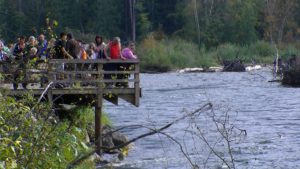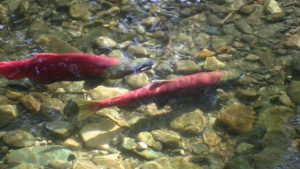 |
Spectators gathering at the Adams River,
October 2010 |
Last month I had the privilege of witnessing the miraculous abundance of Fraser River sockeye returning this year. The Adams River was a whir of activity as people jostled for the best position to see as the salmon fought the currents and each other for the best mate and place for a spawning redd. Tears welled up frequently as I marveled at the beauty and the miracle of their unlikely return.
I say unlikely return, as these fish came back in greater abundance than has been seen in a whole century, despite all mankind’s greed and ignorance has thrown at them. But the tears also came in frustration, and still do, as I hear the fish farm spin doctors churn out the denial and deflect attention from their impacts on wild salmon. “The sockeye have returned and we haven’t changed a thing, so we couldn’t have caused the collapse of Fraser River sockeye last year,” claims the fish farm industry. “The conservationists are wrong.”
Well, why don’t we start by taking a look at what we do know…
Based on peer reviewed published science, we know that sea lice harm wild pink and chum salmon…in fact we know that a heavy sea lice infection can even kill an adult salmon either directly, or by weakening them to be preyed upon or more susceptible to disease. (For instance, the vice president of Cooke Aquaculture in New Brunswick recently told La Presse they “lost 500,000 fish this year” to sea lice infestation.) The body of scientific evidence also continues to grow; just last month
two studies were released on the impacts of sea lice from salmon farms in BC on coho salmon. So how many sea lice does it take to kill a juvenile sockeye? We don’t know, but we do know through
genetic analyses that Fraser stocks have been reported to have sea lice in the vicinity of salmon farms in the
Wild Salmon Narrows farming region. We also know that fish farms are prone to disease outbreaks as seen in BC, Europe and Chile, despite vaccinations and antibiotic use, with devastating effects.
 |
Fraser sockeye returning to their spawing
grounds |
What we don’t know is what the salmon farming industry is hiding when it comes to sea lice and disease on their farms. The salmon farming industry has vehemently resisted the release of these data while claiming that their operations do not have a negative impact on wild fish populations. The Cohen Inquiry into the decline of Fraser River sockeye recently obtained some information from a few farms going back five years (which is yet to be analyzed and also not available to the public), but without access to complete data, no one can adequately assess the impacts and if salmon farms have harmed Fraser sockeye.
It is from this platform of denial and obstruction that the fish farm industry makes baseless and simplistic claims like the one above, attempting to exonerate themselves from any role in the decline of wild salmon while their farms continue to spread sea lice, waste and potentially even disease into our waters.
That’s why we are asking for an emergency migration route for juvenile salmon, a route on the east and north side of Quadra Island in the Wild Salmon Narrows
which needs to be cleared by March to increase the chances of survival for next year’s miraculous juvenile salmon. Immediate measures to remove salmon farms from sockeye migration routes was also
recommended by a think tank of scientists that gathered at Simon Fraser University in December 2009 to discuss possible causes of the Fraser River sockeye collapse. I’m not holding my breath, since both the provincial and federal governments have done little to protect wild salmon from fish farms so far, and in fact are supporting the industry’s expansion. However, this year’s miracle which is the Fraser River sockeye gives me hope that wild salmon can hold on while we continue gaining ground and working hard to get this industry into closed containment.
Credit: this post was originally published by Michelle at http://blog.farmedanddangerous.org


